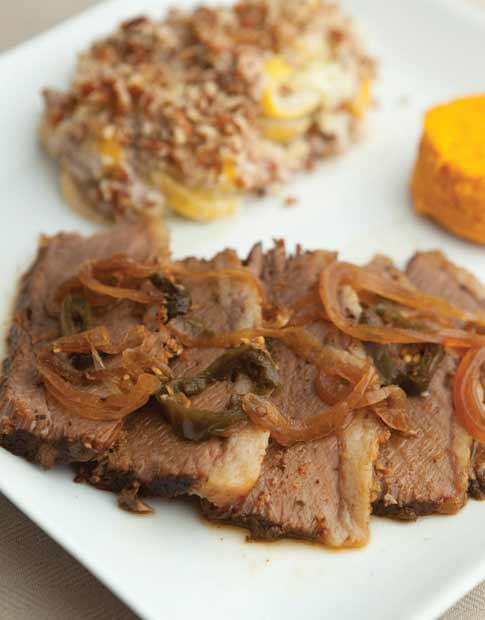Before I met Charles, I did not have an outdoor grill, or a smoker for that matter. Life was very sad in that regard. Which meant getting a bit creative: indoor grill pans that invariably set off my smoke detector, and every now and then using a wee bit of liquid smoke.
There seems to be one universal brisket principle that must be adhered to no matter what recipe you’re following: low and slow. Some of the outdoor smoker recipes cook for 12–16 hours. Fortunately, this one shortens that a bit, and makes your house smell pretty incredible.
Even without the liquid smoke, brisket is some tasty comfort food, and there are literally thousands of recipes out there as to how to prepare.
2 teaspoons salt (optional)
1 tablespoon black pepper
2 teaspoons cayenne
4 cloves fresh garlic, crushed
1 3- to 4-pound (2 kg) brisket, untrimmed
1 yellow or white onion, sliced
¼ cup (60 mL) tamari or coconut aminos
1 tablespoon Worcestershire sauce, optional
2 tablespoons liquid smoke
2 tablespoons brewed espresso or dark coffee
¼ cup (60 mL) apple cider vinegar
1 cup (250 mL) beef stock
3 fresh jalapeños, sliced
- Preheat oven to 250°F (125°C).
- Mix together the salt, black pepper, cayenne, and crushed garlic, and rub all over your brisket. Allow the brisket sit out and come to room temperature.
- In your large roasting pan or a Pyrex 9 inch x 13 inch (23 cm x 33 cm) pan, add in your onions, coconut aminos (or tamari), Worcestershire sauce, the liquid smoke, espresso, apple cider vinegar, beef stock, and some of the jalapeños.
- Set the brisket on top of the onions and jalapeños with the fat side up. Set your remaining jalapeños on top of the brisket.
- Cover the pan tightly with aluminum foil and let bake for at least 4 hours.
- Remove the brisket from the pan, and it should almost fall apart when you touch it. Let it rest outside the pan for at least 20 minutes.
- When ready to serve, trim the fat from the top, and slice very thin against the grain.
Ingredient Notes—Liquid smoke comes in all varieties, some with all kinds of additives. You want to find one where its only ingredient is “natural liquid smoke.” How is this made in the first place? Manufacturers heat the given wood (typically hickory) over a heat high enough to get it smoldering, and then that smoke is passed through water to create the liquid smoke. It’s then refined for impurities and barreled much like whiskey. As with everything in life, there is debate about the safety of liquid smoke. According to the European Commission, “Because smoke flavorings . . . are subject to fractionalization and purification . . . the use of liquid smoke flavorings is generally considered to be less of a health concern than the traditional smoking process.” For what it’s worth, I surely wouldn’t down bottles of this, but a few tablespoons seem pretty reasonable to try and get that smoky flavor.


